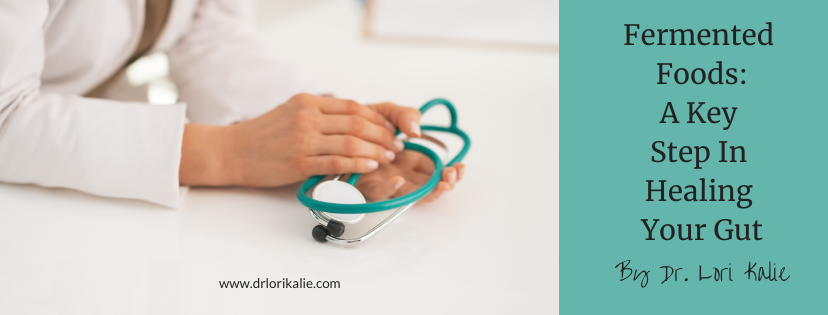Do you eat fermented foods regularly? If not, you’re missing an easy way to make your gut healthier. And a healthier gut means a happier and more vibrant you! If your gut isn’t right, you can eat super healthy and still struggle with feeling flat and not quite yourself. Does this sound familiar?
Gut health is a very important component in healing your thyroid. T4 is covered to T3 in the gut. Also, 80% of your immune system is located in your gut. If you have Hashimoto’s, improving the way your immune system is functioning is key.
Because fermented foods are super important for healing the gut and balancing out the countless good and bad bacteria that live there, they could be your secret weapon for unlocking your vibrant self.
What are fermented foods?

Fermented Foods To Heal The Gut
Fermented foods undergo a process called lacto-fermentation. If you’ve never heard of this, it’s how foods were preserved before refrigeration become an option. The “lacto” part is nothing to do lactose; it’s actually referring to the lactobacilli bacteria that are involved in the process.
The benefits of fermented foods
A healthy gut environment is super important for your hormones, immunity, digestion and nervous system, which can potentially mean big changes to your health.
According to a 2011 study published in the Nutrition Research Journal, fermented kimchi supports weight loss and can help to reduce body fat in people who are overweight – much more so than fresh kimchi. Plus, it can improve metabolic and cardiovascular disease markers such as blood pressure, fasting blood glucose levels and waist-to-hip ratio. Other research has linked kimchi to lower cholesterol levels and it may be able to protect against constipation, osteoarthritis, atherosclerosis and even cancer.
Fermented foods can be great if you’ve been experiencing problems such as food intolerances, yeast infections, digestive issues and allergies. These can often stem from an unhealthy gut and fermented foods can help to tackle this.
For immunity, good bacteria is involved in helping your body to recognize foreign threats and distinguish them from normal, healthy cells, make more antibodies and help white blood cells to fight infection.
Basically, they give your body the tools to start healing, which is crucial for your health and wellbeing. And for anyone with health issues that stem from inflammation, they can help to calm things down. This is particularly great for people with autoimmune conditions, which are often highly inflammatory.
And with as much as 90% of your levels of serotonin (a neurotransmitter that is heavily involved in mood) being made in your gut, fermented foods can be a really underrated way to help you to improve your wellbeing and feel better and more vibrant.
What to eat
Some examples of fermented foods include:
- Sauerkraut (fermented cabbage)
- Kombucha (a fermented tea)
- Kefir (a fermented milk drink)
- Kimchi (a side dish made from fermented vegetables)
- Yogurt with live cultures
- Fermented vegetables
If you want to add more fermented foods into your diet, try including 1-2 tablespoons of them with meals and build up from there. Experts suggest you’ll get the best benefits from eating half a cup of fermented foods with foods. And as you’ll see in the next section, it’s not that difficult to make them yourself.
Making your own fermented foods
Homemade fermented foods tend to have more bacteria (both bad and good) than most of the ones you’ll find in the grocery store. Pasteurization can kill off as much as 80% of the bacteria in shop bought fermented foods, which also destroys most of their benefits. Making your own fermented veggies means you don’t have to worry about that and it’s not as difficult as you might think!
For the fermentation process, you’ll need a fermentation container such as a large, clean glass jar and some sea salt (around 1-3 tablespoons for every liter of water that you’re using).
Chop up your chosen veggies as finely as you can and sprinkle with the salt. Massage the salt into the vegetables for around 5 minutes. If you don’t want to use your hands, you can try a potato masher instead for this part. You should have started to produce a brine at this point. Carry on with this until your vegetables are covered in the brine and transfer to the fermentation container. Ideally, the veggies will be completely under the brine and not peeking out. If this isn’t the case, the bacteria won’t be able to do its work properly in fermenting them. You may need to add a touch more water to the jar to make sure that everything is fully submerged.
Once you’re done, cover the container with a very tight fitting lid. Leave it at room temperature and over the next couple of weeks, it should ferment naturally. If your container has a ultra tight lid, you’ll need to unscrew it every day to let some of the pressure out of the jar.
Download my FREE 5-Day Thyroid Recovery Plan. You will get information about how to reverse your thyroid condition and a meal plan and thyroid friendly recipes for 5 days.






